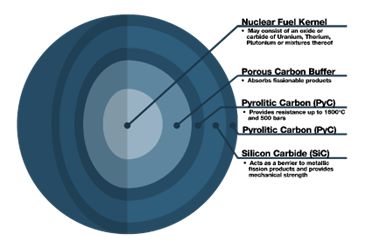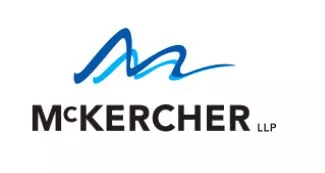On June 29, 2023, the Canadian Nuclear Safety Commission (the "CNSC") and the United States Nuclear Regulatory Commission (the "US NRC" and, together with the CNSC, the "Regulators") released their joint Report titled "Final Report concerning Tristructural Isotropic (TRISO) Fuel Qualification"1 (the "Report").2 The Report establishes a common regulatory position between the Regulators on the qualification of tristructural isotropic (TRISO) fuels and identifies gaps in the understanding of the technology. This Report is a significant step forward for use of TRISO fuels in North America.
TRISO fuels are not a novel concept;3 however, interest in the technology has increased with the advancement of nuclear reactors and the desire for safer alternatives to traditional fuels. TRISO fuels are a formidable fuel alternative since they can withstand pressures and temperatures of up to 500 bar and 1600°C, respectively, and can resist neutron irradiation, corrosion and oxidation.4 These characteristics provide protections from conditions consistent with nuclear meltdowns and are a result of the fuel's structural design.
TRISO fuel consists of a nuclear material encased by three layers of "isotropic materials" – usually in a spherical or cylindrical geometry. Though each particular design can vary, TRISO fuels are typically coated in three different layers: (1) carbon, which absorbs the nuclear reaction products; (2) pyrolytic carbon, which provides the fuel's ability to withstand high temperatures and pressure; and (3) silicon carbide, which contains metallic fission products and provides additional strength.5 The bulk of the Report's discussion centers on the literature concerning the structure of TRISO fuel, its promised qualities and its ability to withstand the conditions of nuclear reactors.

Figure 1: Diagram of a typical TRISO fuel pellet
The Report outlines the Regulator's common position on the regulation and assessment of TRISO fuels. In particular, the Report acknowledges the broad range of operating conditions at which TRISO fuels may be used and identifies areas of concern, regulatory gaps, important qualification metrics and areas requiring further investigation. Though the Report confirms various broad generalities applicable to TRISO fuels, it emphasizes the need to regulate each proposed use on a case-by-case basis6 subject to existing regulatory practices in place.
Canada's nuclear regulations are designed to be broad; however, they have been, for the most part, only applied commercially to Canada Deuterium Uranium (CANDU) reactors – a Canadian-designed heavy water reactor. The application of these regulations to TRISO fuels will pose new challenges where cooperation with industry will play a vital role. Notably, the Report speaks to ongoing engagements by the Regulators with Kairos Power, Ultra-Safe Nuclear Corporation ("Ultra-Safe") and X-Energy who have all proposed the use of TRISO fuels in their reactor designs.
Ultra-Safe has been working with Canadian Nuclear Laboratories (CNL) to develop TRISO fuels7 and has an active microreactor deployment project in Chalk River, Ontario.8 Likewise, X-Energy has been particularly active in Saskatchewan, agreeing to collaborate with Cameco9, the First Nation Power Authority10 and the Saskatchewan Industrial & Mining Suppliers Association Inc.,11 among others, to explore opportunities and build capacity for advanced small modular reactors.
The Report marks a pivotal moment in nuclear fuel technology and offers a promising pathway towards a safer and more resilient approach to nuclear energy production. Though the Report highlights critical areas for ongoing research and regulatory adaptation for the safe and risk-informed use of TRISO fuels, it has also opened up a new avenue for proponents hoping to deploy their rector designs in Canada.
A business that is considering a resource project should consult legal counsel. McKercher LLP has lawyers with considerable experience assisting businesses with regulatory compliance, financing, resource projects, and implementation of new technologies. If you have any questions or comments about the above, please do not hesitate to contact a lawyer from our Natural Resource Practice Group..
Footnotes
1. The Report was prepared pursuant to the "Memorandum of Cooperation on Advanced Reactor and Small Modular Reactor Technologies between the Canadian Nuclear Safety Commission and the United States Nuclear Regulator Commission" executed August 15, 2019, which is aimed at enhancing cooperation in areas that include reactor design, research, staff training, and the comparison of regulatory practices.
2. United States Nuclear Regulatory Commission and Canadian Nuclear Safety Commission, "Final Report concerning Tristructural Isotropic (TRISO) Fuel Qualification" [Report], (June 2023) at 6, online (pdf): < nrc.gov>[https://web.archive.org/web/20231113204516/https://www.nrc.gov/docs/ml2317/ml23172A242.pdf]. In particular the Report aims to: (1) Provide the evidentiary basis to support regulatory findings; (2) Identify areas of TRISO fuel qualification that are design dependent; and (3) Highlight areas where additional information, testing, or both are needed to support regulatory approval.
3. Sonal Patel, The Allure of TRISO Nuclear Fuel Explained, (1 March 2021), online: Power Magazine [https://www.powermag.com/the-allure-of-triso-nuclear-fuel-explained/].
4. Portal et al "Coated particle fuel to improve safety, design, economics in water-cooled and gas-cooled reactors" 38: 3-4 Progress in Nuclear Energy 407 at 408.
5. J Portal et al "Coated particle fuel to improve safety, design, economics in water-cooled and gas-cooled reactors" 38: 3-4 Progress in Nuclear Energy 407 at 408 [J Portal].
6. Report, supra 1 at 28.
7. Canadian Nuclear Laboratories, "CNL successfully fabricates advanced Small Modular Reactor fuels", (13 April 2021), online (blog): [http://web.archive.org/web/20231113195004/https://www.cnl.ca/cnl-successfully-fabricates-advanced-small-modular-reactor-fuel/].
8. Ultra Safe Nuclear Corporation, "McMaster University, Ultra Safe Nuclear Corporation, and Global First Power Sign MOU to Study Deployment of Micro Modular Reactor (MMR®)", (11 December 2022), online (blog): [https://web.archive.org/web/20230811130025/https://www.usnc.com/mcmaster-university-ultra-safe-nuclear-corporation-and-global-first-power-sign-mou-to-study-deployment-of-micro-modular-reactor-mmr/].Canadian Nuclear Laboratories, "AECL, CNL and Global First Power unveil the site of GFP's proposed small modular reactor at the Chalk River Laboratories" (12 May 2023), online:[https://www.cnl.ca/aecl-cnl-and-global-first-power-unveil-the-site-of-gfps-proposed-small-modular-reactor-at-the-chalk-river-laboratories/].
9. X-energy, "X-energy and Cameco to Explore Collaboration to Support Xe-100 Small Modular Reactors", (16 September 2021), online (blog): [https://web.archive.org/web/20231113202642/https://x-energy.com/media/news-releases/x-energy-and-cameco-to-explore-collaboration-to-support-xe-100-small-modular-reactors].
10. X-energy, "X-energy Canada and First Nations Power Authority Collaborate to Build Indigenous Capacity for Future Advanced Small Modular Reactor Industry", (15 December 2021), online (blog): [https://web.archive.org/web/20231113202836/https://x-energy.com/media/news-releases/x-energy-canada-and-first-nations-power-authority-collaborate-to-build-indigenous-capacity-for-future-advanced-small-modular-reactor-industry].
11. X-energy, "X-energy Canada and SIMSA Collaborate to Support the Potential Deployment of Xe-100 Small Modular Reactors" (26 July 2022), online (blog): [https://web.archive.org/web/20231113203202/https://x-energy.com/media/news-releases/x-energy-canada-and-simsa-collaborate-to-support-the-potential-deployment-of-xe-100-small-modular-reactors].
The content of this article is intended to provide a general guide to the subject matter. Specialist advice should be sought about your specific circumstances.


